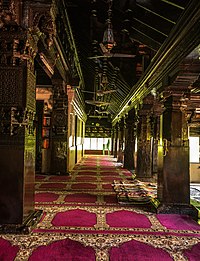Goan Muslims
| Languages | |
|---|---|
Konkani | |
| Religion | |
| Islam | |
| Related ethnic groups | |
| Goans, Nawayath, Konkani Muslims |
| Part of a series on |
| Islam in India |
|---|
 |
The Goan Muslims are a minority community who follow
History
Although the advent of Muslims in Goa occurred later in history,
The copper plate of
The
By the time the Portuguese arrived in 1510, the population of
From 1560 to 1821, the Goa Inquisition was established. One of its primary targets were crypto-Muslims of North African origin who had immigrated to Goa from the Iberian peninsula following the Portuguese conquest. Of the 1,582 persons convicted between 1560 and 1623, 45.2% were convicted for offenses related to Judaism and Islam.[12] However, a compilation of the auto-da-fé statistics of the Goa Inquisition from 1560 to 1821 revealed that a grand total of only 57 persons were burnt in the flesh and 64 in effigy (i.e. a statue resembling the person). All the burnt were convicted as relapsed heretics or for sodomy.[13]
Demography
Native Goan Muslims are concentrated in the
Culture
Castes
The majority of Goan Muslims follow Sunni Islam,[16] the predominant groups being that of:
- Mulla's (Mulam/Mullam in Portuguese),
- Muzawar's (Muzavor in Portuguese),
- Sayyid's (Soiada/Soid in Portuguese),
- Shaikh's(Xec in Portuguese),
- Khan's (Can in Portuguese),
- Shaa's (Xaa in Portuguese),
- Kazi's (Cazi in Portuguese).
- Beig's (BEC in Portuguese),
Festivals
They observe all Muslim holidays and festivals such as
Inter-Communal Relations
Goan Muslims are vastly outnumbered in Goa by non-Goan Muslims, because of the mass immigration taking place from other states of India since the
Law
Goan Muslims as well as
Cuisine
Like Goans of other faiths, Goan Muslims' staple foods are rice and fish. Sea food is preferred to
Notes
References
- ISBN 9788171547609.)
{{cite book}}: CS1 maint: multiple names: authors list (link - ^ "Journal of the Asiatic Society of Bombay". Asiatic Society of Bombay. 11: 292.
- ISBN 9788120605954.
- ISBN 9781853596735.
- ^ Mitragotri, Vithal Raghavendra (1999). A socio-cultural history of Goa from the Bhojas to the Vijayanagara. Institute Menezes Braganza. pp. 74–75.
- ISBN 9788170222637.
- ISBN 9781900949453.
- ISBN 9781853596735.
- ^ D'Souza, Bento Graciano (1975). Goan Society in Transition: A Study in Social Change. Popular Prakashan. p. 54.
- ^ Machado Prabhu, Alan (1999). Sarasvati's Children: A History of the Mangalorean Christians. I.J.A. Publications.
- ^ Crowley, Roger (2015). Conquerors: How Portugal Forged the First Global Empire. London: Faber & Faber.
- ^ Delgado Figueira, João (1623). Listas da Inquisição de Goa (1560-1623). Lisbon: Biblioteca National.
- ^ de Almeida, Fortunato (1923). História da Igreja em Portugal, vol. IV. Porto: Portucalense Editora.
- ^ Śiroḍakara, Pra. Pā (1992). Goa's external relations: seminar papers. Rajhauns Vitaran.
- ^ Śiroḍakara, Pra. Pā (1992). Goa's external relations: seminar papers. Rajhauns Vitaran. p. 12.
- ^ ISBN 9788171547609.)
{{cite book}}: CS1 maint: multiple names: authors list (link - ^ Fatihi, A. R. "URDU IN GOA". LANGUAGE IN INDIA. Retrieved 2 February 2012.
- ^ "India's religions by numbers". The Hindu (published 26 August 2015). 29 March 2016. Archived from the original on 10 January 2016. Retrieved 6 September 2017.
- ^ "Communal violence in Goa". Gomantak Times. 3–4 March 2006. p. 1.
- ISBN 9788185880044.)
{{cite book}}: CS1 maint: multiple names: authors list (link - ISBN 9781845376192.
- ^ Furtado, A. D. (1981). Goa, yesterday, to-day, tomorrow: an approach to various socio-economic and political issues in Goan life & re-interpretation of historical facts. Furtado's Enterprises. p. xviii.
- ^ Gomantak:Prakruti ani Sanskruti-Goa:Nature and Culture, volume I, by Satoskar B.D

